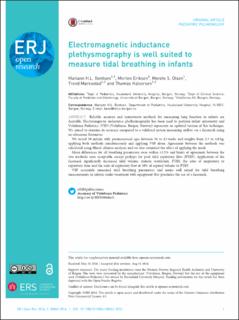| dc.contributor.author | Bentsen, Mariann | |
| dc.contributor.author | Eriksen, Morten | |
| dc.contributor.author | Olsen, Merete Susan | |
| dc.contributor.author | Markestad, Trond | |
| dc.contributor.author | Halvorsen, Thomas | |
| dc.date.accessioned | 2022-11-17T12:49:33Z | |
| dc.date.available | 2022-11-17T12:49:33Z | |
| dc.date.created | 2017-02-22T23:30:27Z | |
| dc.date.issued | 2016 | |
| dc.identifier.issn | 2312-0541 | |
| dc.identifier.uri | https://hdl.handle.net/11250/3032453 | |
| dc.description.abstract | Reliable, accurate and noninvasive methods for measuring lung function in infants are desirable. Electromagnetic inductance plethysmography has been used to perform infant spirometry and VoluSense Pediatrics (VSP) (VoluSense, Bergen, Norway) represents an updated version of this technique. We aimed to examine its accuracy compared to a validated system measuring airflow via a facemask using an ultrasonic flowmeter.
We tested 30 infants with postmenstrual ages between 36 to 43 weeks and weights from 2.3 to 4.8 kg, applying both methods simultaneously and applying VSP alone. Agreement between the methods was calculated using Bland–Altman analyses and we also estimated the effect of applying the mask.
Mean differences for all breathing parameters were within ±5.5% and limits of agreement between the two methods were acceptable, except perhaps for peak tidal expiratory flow (PTEF). Application of the facemask significantly increased tidal volume, minute ventilation, PTEF, the ratio of inspiratory to expiratory time and the ratio of expiratory flow at 50% of expired volume to PTEF.
VSP accurately measured tidal breathing parameters and seems well suited for tidal breathing measurements in infants under treatment with equipment that precludes the use of a facemask. | en_US |
| dc.language.iso | eng | en_US |
| dc.publisher | European Respiratory Society | en_US |
| dc.rights | Navngivelse-Ikkekommersiell 4.0 Internasjonal | * |
| dc.rights.uri | http://creativecommons.org/licenses/by-nc/4.0/deed.no | * |
| dc.title | Electromagnetic inductance plethysmography is well suited to measure tidal breathing in infants | en_US |
| dc.type | Journal article | en_US |
| dc.type | Peer reviewed | en_US |
| dc.description.version | publishedVersion | en_US |
| dc.rights.holder | Copyright ERS 2016 | en_US |
| dc.source.articlenumber | 00062 | en_US |
| cristin.ispublished | true | |
| cristin.fulltext | original | |
| cristin.qualitycode | 1 | |
| dc.identifier.doi | 10.1183/23120541.00062-2016 | |
| dc.identifier.cristin | 1453281 | |
| dc.source.journal | ERJ Open Research | en_US |
| dc.identifier.citation | ERJ Open Research. 2016, 2 (4), 00062. | en_US |
| dc.source.volume | 2 | en_US |
| dc.source.issue | 4 | en_US |

